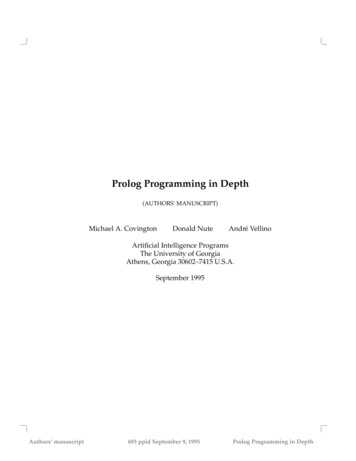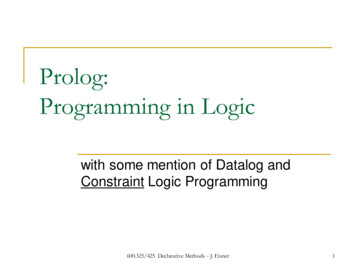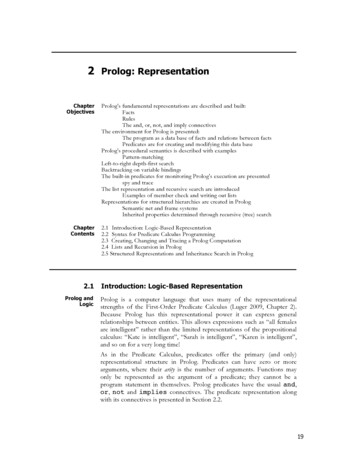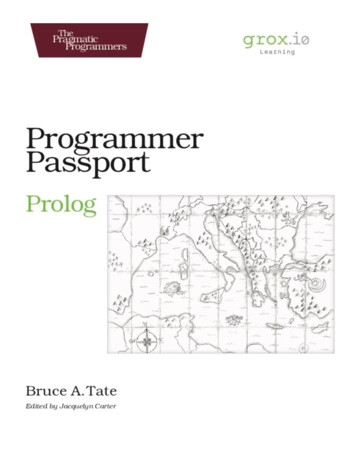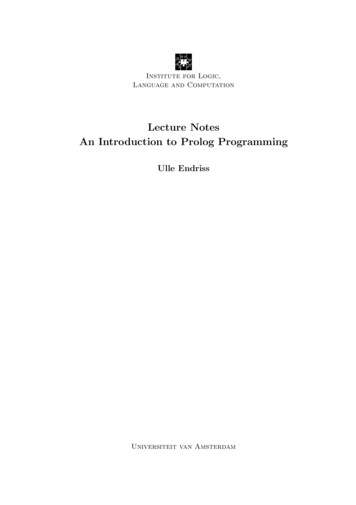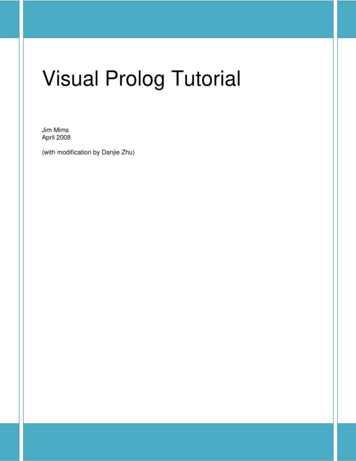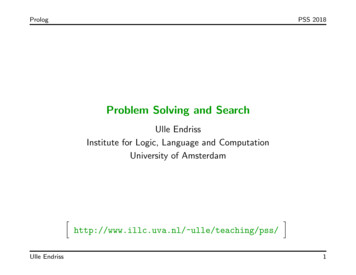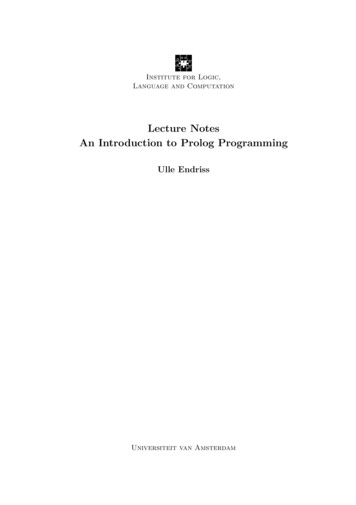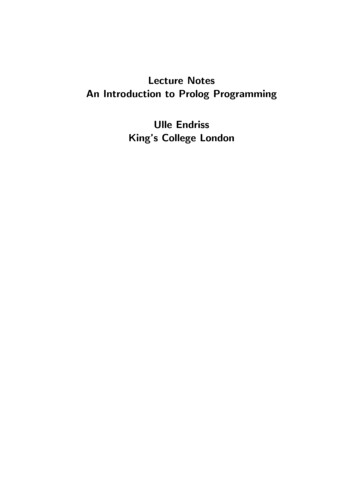
Transcription
Lecture NotesAn Introduction to Prolog ProgrammingUlle EndrissKing's College London
c by Ulle Endriss, King's College London (endriss@dcs.kcl.ac.uk)Version: September 24, 2000
Contents1 The Basics1.1 Introduction . . . . . . . . . . . . . . .1.2 Getting Started: An Example . . . . .1.3 Prolog Syntax . . . . . . . . . . . . . .1.3.1 Terms . . . . . . . . . . . . . .1.3.2 Clauses, Programs and Queries1.3.3 Some Built-in Predicates . . .1.4 Answering Queries . . . . . . . . . . .1.4.1 Matching . . . . . . . . . . . .1.4.2 Goal Execution . . . . . . . . .1.5 A Matter of Style . . . . . . . . . . . .1.6 Exercises . . . . . . . . . . . . . . . .Notation . . . . . . . . . . . . . . . . . . . . . .Head and Tail . . . . . . . . . . . . . . . . . . .Some Built-in Predicates for List ManipulationExercises . . . . . . . . . . . . . . . . . . . . .2 List 233 Arithmetic Expressions254 Operators315 Backtracking, Cuts and Negation393.1 The is-Operator for Arithmetic Evaluation . . . . . . . . . . . . . . .3.2 Prede ned Arithmetic Functions and Relations . . . . . . . . . . . . .3.3 Exercises . . . . . . . . . . . . . . . . . . . . . . . . . . . . . . . . . .4.1 Precedence and Associativity . . . . . . . . . . . . . . . . . . . . . . .4.2 Declaring Operators Using the op-Predicate . . . . . . . . . . . . . . .4.3 Exercises . . . . . . . . . . . . . . . . . . . . . . . . . . . . . . . . . .5.1 Backtracking and Cuts . . . . . . . .5.1.1 Backtracking Revisited . . . .5.1.2 Problems with Backtracking .5.1.3 Introducing Cuts . . . . . . .3.25262731343539394041
4Contents5.25.35.45.55.1.4 Problems with Cuts . . . . . .Negation as Failure . . . . . . . . . . .5.2.1 The Closed World Assumption5.2.2 The n -Operator . . . . . . . .Disjunction . . . . . . . . . . . . . . .Example: Evaluating Logic Formulas .Exercises . . . . . . . . . . . . . . . .444545454747496 Logic Foundations of Prolog53A Recursive Programming596.1 Translation of Prolog Clauses into Formulas . . . . . . . . . . . . . . .6.2 Horn Formulas and Resolution . . . . . . . . . . . . . . . . . . . . . .6.3 Exercises . . . . . . . . . . . . . . . . . . . . . . . . . . . . . . . . . .A.1A.2A.3A.4Complete Induction . .The Recursion PrincipleWhat Problems to SolveDebugging . . . . . . . .53555759606161
Chapter 1The Basics1.1 IntroductionProlog (pro gramming in log ic) is one of the most widely used programming languagesin arti cial intelligence research. As opposed to imperative languages such as C or Java(which also happens to be object-oriented) it is a declarative programming language.That means, when implementing the solution to a problem, instead of specifying howto achieve a certain goal in a certain situation, we specify what the situation (rules andfacts ) and the goal (query ) are and let the Prolog interpreter derive the solution for us.Prolog is very useful in some problem areas, like arti cial intelligence, natural languageprocessing, databases, . . . , but pretty useless in others, like graphics or numericalalgorithms.By following this course, rstly you will learn how to use Prolog as a programminglanguage to solve certain problems in computer science and arti cial intelligence, andsecondly you will learn how the Prolog interpreter actually works. The latter will alsoinclude an introduction to the logical foundations of the Prolog language.These notes cover the most important Prolog concepts you'll need to know about,but it is certainly worthwhile to also have a look at the literature. The following threeare well known titles, but you may also consult any other textbook on Prolog.[1] I. Bratko. Prolog Programming for Arti cial Intelligence. 2nd edition, AddisonWesley Publishing Company, 1990.[2] F. W. Clocksin and C. S. Mellish. Programming in Prolog. 4th edition, SpringerVerlag, 1994.[3] L. Sterling and E. Shapiro. The Art of Prolog. MIT Press, 1986.1.2 Getting Started: An ExampleIn the introduction it has been said that Prolog is a declarative (or descriptive) language. Programming in Prolog means describing the world. Using such programs5
6Chapter 1. The Basicsmeans asking Prolog questions about the previously described world. The simplestway of describing the world is by stating facts, like this one:bigger( elephant, horse).This states, quite intuitively, the fact that an elephant is bigger than a horse.(Whether the world described by a Prolog program has anything to do with our realworld is of course entirely up to the programmer.) Let's add a few more facts to ourlittle program:bigger(bigger(bigger(bigger(elephant, horse).horse, donkey).donkey, dog).donkey, monkey).This is a syntactically correct program, and after having compiled it we can askthe Prolog system questions (or queries in proper Prolog-jargon) about it. Here's anexample:?- bigger( donkey, dog).YesThe query bigger( donkey, dog) (i.e. the question \Is a donkey bigger than adog?") succeeds, because the fact bigger( donkey, dog) has been communicated tothe Prolog system before. Now, is a monkey bigger than an elephant?- bigger( monkey, elephant).NoNo, it's not. We get exactly the answer we expected: the corresponding query,namely bigger( monkey, elephant) fails. But what happens when we ask the otherway round?- bigger( elephant, monkey).NoAccording to this elephants are not bigger than monkeys. This is clearly wrongas far as our real world is concerned, but if you check our little program again, youwill nd that it says nothing about the relationship between elephants and monkeys.Still, we know that if elephants are bigger than horses, which in turn are bigger thandonkeys, which in turn are bigger than monkeys, then elephants also have to be biggerthan monkeys. In mathematical terms: the bigger-relation is transitive. But thishas also not been de ned in our program. The correct interpretation of the negativeanswer Prolog gave is the following: from the information communicated to the systemit cannot be proved that an elephant is bigger than a monkey.If, however, we would like to get a positive reply for a query like bigger(elephant, monkey), we have to provide a more accurate description of the world. One
Ulle Endriss. An Introduction to Prolog Programming7way of doing this would be to add the remaining facts, like e.g. bigger( elephant,monkey). For our little example this would mean adding another 5 facts. Clearly toomuch work and probably not too intelligible anyway.The far better solution would be to de ne a new relation, which we will callis bigger, as the transitive closure of bigger. Animal X is bigger than animal Yeither if this has been stated as a fact or if there is an animal Z for which it hasbeen stated as a fact that animal X is bigger than animal Z and it can be shown thatanimal Z is bigger than animal Y. In Prolog such statements are called rules and areimplemented like this:is bigger( X, Y) :- bigger( X, Y).is bigger( X, Y) :- bigger( X, Z), is bigger( Z, Y).In these rules :- means something like if' and the comma between the two termsbigger( X, Z) and is bigger( Z, Y) stands for and'. X, Y, and Z are variables,which in Prolog is indicated by using capital letters.If from now on we use is bigger instead of bigger in our queries, the programwill work as intended:?- is bigger( elephant, monkey).YesProlog still cannot nd the fact bigger( elephant, monkey) in its database, soit tries to use the second rule instead. This is done by matching the query withthe head of the rule, which is is bigger( X, Y). When doing so the two variablesget instantiated: X elephant and Y monkey. The rule says, that in order toprove the goal is bigger( X, Y) (with the variable instantiations that's equivalentto is bigger( elephant, monkey)) Prolog has to prove the two subgoals bigger( X,Z) and is bigger( Z, Y) { again with the same variable instantiations. This processis repeated recursively until the facts that make up the chain between elephant andmonkey are found and the query nally succeeds. How this goal execution as well asterm matching and variable instantiation really work will be examined in more detailin Section 1.4.Of course, we can do slightly more exiting stu than just asking yes/no-questions.Suppose we want to know, what animals are bigger than a donkey? The correspondingquery would be:?- is bigger( X, donkey).Again, X is a variable. We could also have chosen any other name for it as long asit starts with a capital letter. The Prolog interpreter replies as follows:?- is bigger( X, donkey).X horseHorses are bigger than donkeys. The query has succeeded, but in order to allowit to succeed Prolog had to instantiate the variable X with the value horse. If this
8Chapter 1. The Basicsmakes us happy already, we can press Return now and that's it. In case we want tond out if there are more animals that are bigger than the donkey, we can press thesemicolon key, which will cause Prolog to search for alternative solutions to our query.If we do this once, we get the next solution X elephant: elephants are also biggerthan donkeys. Pressing semicolon again will return a No, because there are no moresolutions:?- is bigger( X, donkey).X horse ;X elephant ;NoThere are many more ways of querying the Prolog system about the contents of itsdatabase. As a nal example we ask whether there is an animal X that is both smallerthan a donkey and bigger than a monkey:?- is bigger( donkey, X), is bigger( X, monkey).NoThe (correct) answer is No. Even though the two single queries is bigger(donkey, X) and is bigger( X, monkey) would both succeed when submitted ontheir own, their conjunction (represented by the comma) does not.This section has been intended to give you a rst impression of Prolog programming. The next section provides a more systematic overview of the basic syntax.There are a number of Prolog interpreters around. How to start a Prolog session mayslightly di er from one system to the other. Details about this will be given duringthe course.1.3 Prolog SyntaxThis section describes the most basic features of the Prolog programming language.1.3.1TermsThe central data structure in Prolog is that of a term. There are terms of four kinds:atoms, numbers, variables, and compound terms. Atoms and numbers are sometimesgrouped together and called atomic terms.Atoms. Atoms are usually strings made up of lower- and uppercase letters, digits,and the underscore, starting with a lowercase letter. The following are all valid Prologatoms:elephant, b, abcXYZ, x 123, another pint for me pleaseOn top of that also any series of arbitrary characters enclosed in single quotesdenotes an atom.
Ulle Endriss. An Introduction to Prolog Programming9'This is also a Prolog atom.'Finally, strings made up solely of special characters like - * : & (checkthe manual of your Prolog system for the exact set of these characters) are also atoms.Examples: , ::, ------ , ***Numbers. All Prolog implementations have an Integer type: a sequence of digits,optionally preceded by a - (minus). Some also support Floats. Check the manual fordetails.Variables. Variables are strings of letters, digits, and the underscore, starting witha capital letter or an underscore. Examples:X, Elephant, 4711, X 1 2, MyVariable,The last one of the above examples (the single underscore) constitutes a special case.It is called the anonymous variable and is used when the value of a variable is of noparticular interest. Multiple occurrences of the anonymous variable in one expressionare assumed to be distinct, i.e. their values don't necessarily have to be the same.More on this later.Compound terms. Compound terms are made up of a functor (a Prolog atom)and a number of arguments (Prolog terms, i.e. atoms, numbers, variables, or othercompound terms) enclosed in parentheses and separated by commas. The followingare some examples for compound terms:is bigger( horse, X), f( g( X, ), 7), 'My Functor'( dog)It's important not to put any blank characters between the functor and the openingparentheses, or Prolog won't understand what you're trying to say. In other positions,however, spaces can be very helpful for making programs more readable.The sets of compound terms and atoms together form the set of Prolog predicates.A term that doesn't contain any variables is called a ground term.1.3.2Clauses, Programs and QueriesIn the introductory example we have already seen how Prolog programs are made upof facts and rules. Facts and rules are also called clauses.Facts. A fact is a predicate followed by a dot. Examples:bigger( whale, ).life is beautiful.The intuitive meaning of a fact is that we de ne a certain instance of a relation asbeing true.
10Chapter 1. The BasicsRules. A rule consists of a head (a predicate) and a body. (a sequence of predicatesseparated by commas). Head and body are separated by the sign :- and, like everyProlog expression, a rule has to be terminated by a dot. Examples:is smaller( X, Y) :- is bigger( Y, X).aunt( Aunt, Child) :sister( Aunt, Parent),parent( Parent, Child).The intuitive meaning of a rule is that the goal expressed by its head is true, if we(or rather the Prolog system) can show, that all of the expressions (subgoals) in therule's body are true.Programs. A Prolog program is a sequence of clauses.Queries. After compilation a Prolog program is run by submitting queries to theinterpreter. A query has the same structure as the body of a rule, i.e. it is a sequenceof predicates separated by commas and terminated by a dot. They can be entered atthe Prolog prompt, which in most implementations is ?-. When writing about querieswe often include the ?-. Examples:?- is bigger( elephant, donkey).?- small( X), green( X), slimy( X).Intuitively, when submitting a query like the last example, we ask Prolog whetherall its predicates are provably true, or in other words whether there is an X such thatsmall( X), green( X), and slimy( X) are all true.1.3.3Some Built-in PredicatesWhat we have seen so far is already enough to write simple programs by de ningpredicates in terms of facts and rules, but Prolog also provides a range of useful builtin predicates. Some of them will be introduced in this section; most of them areexplained in the manual.Built-ins can be used in a similar way as user-de ned predicates. The importantdi erence between the two is, that a built-in predicate is not allowed to appear as theprincipal functor in a fact or the head of a rule. This must be so, because using themin such a position would e ectively mean changing their de nition.Maybe the most important built-in predicate is (equality). Instead of ( X,Y) we usually write more conveniently X Y. Such a goal succeeds, if the terms X andY can be matched. This will be made more precise in Section 1.4.Sometimes it can be useful to have predicates that are known to either fail orsucceed in any case. The predicates true and fail serve exactly this purpose.
Ulle Endriss. An Introduction to Prolog Programming11Program les can be compiled using the predicate consult/1.1 The argumenthas to be a Prolog atom denoting the particular program le. For example, to compilethe le big-animals.pl submit the following query to Prolog:?- consult( 'big-animals.pl').If the compilation is successful, Prolog will reply with Yes. Otherwise a list oferrors is displayed.If besides Prolog's replies to queries you wish your program to have further outputyou can use the write/1 predicate. The argument can be any valid Prolog term. Inthe case of a variable its value will be printed out. Execution of the predicate nl/0causes the system to skip a line. Here are two examples:?- write( 'Hello World!'), nl.Hello World!Yes?- X elephant, write( X), nl.elephantX elephantYesIn the second example rst the variable X is bound to the atom elephant and thenthe value of X, i.e. elephant, is written on the screen using the write/1 predicate.After skipping to a new line Prolog reports the variable binding(s), i.e. X elephant.Checking the type of a Prolog term. There are a number of built-in predicatesavailable that can be used to check the type of a given Prolog term. Here are someexamples:?- atom(elephant).Yes?- atom(Elephant).No?- X f(mouse), compound(X).X f(mouse)YesThe last query succeeds, because the variable X is bound to the compound termf(mouse) at the time the subgoal compound(X) is being executed.Most Prolog systems also provide a help function in the shape of a predicate,usually called help/1. Applied to a term (like the name of a built-in predicate) thesystem will display a short description, if available. Example:1The/1is used to indicate that this predicate takes one argument.
12Chapter 1. The Basics?- help(atom).atom( Term)Succeeds if Term is bound to an atom.1.4 Answering QueriesWe have mentioned the issue of term matching before in these notes. This concept iscrucial to the way Prolog replies to queries, so we present it before describing whatactually happens when a query is processed (or more generally speaking: when a goalis executed).1.4.1MatchingTwo terms are said to match if they are either identical or if they can be made identicalby means of variable instantiation. Instantiating a variable means assigning it a xedvalue. Two free variables also match, because they could be instantiated with thesame ground term.It is important to note that the same variable has to be instantiated with the samevalue throughout an expression. The only exception to this rule is the anonymousvariable , which is considered to be unique whenever it occurs.We give some examples. The terms is bigger( X, dog) and is bigger(elephant, dog) match, because the variable X can be instantiated with the atomelephant. We could test this in the Prolog interpreter by submitting the corresponding query to which Prolog would react by listing the appropriate variable instantiations:?- is bigger( X, dog) is bigger( elephant, dog).X elephantYesThe following is an example for a query that doesn't succeed, because X cannotmatch with 1 and 2 at the same time.?- p( X, 2, 2) p( 1, Y, X).NoIf, however, instead of X we use the anonymous variable , matching is possible,because every occurrence of represents a distinct variable. During matching Y isinstantiated with 2:?- p( , 2, 2) p( 1, Y, ).Y 2YesAnother example for matching:
Ulle Endriss. An Introduction to Prolog Programming13?- f( a, g( X, Y)) f( X, Z), Z g( W, h( X)).X aY h(a)Z g(a, h(a))W aYesSo far so good. But what happens, if matching is possible even though no speci cvariable instantiation has to be enforced (like in all previous examples)? Consider thefollowing query:?- X my functor( Y).X my functor( G177)Y G177YesIn this example matching succeeds, because X could be a compound term with thefunctor my functor and a non-speci ed single argument. Y could be any valid Prologterm, but it has to be the same term as the argument inside X. In Prolog's output thisis denoted through the use of the variable G177. This variable has been generatedby Prolog during execution time. Its particular name { G177 in this case { will bedi erent every time the query is submitted.1.4.2Goal ExecutionSubmitting a query means asking Prolog to try to prove that the statement(s) impliedby the query can be made true provided the right variable instantiations are made.The search for such a proof is usually referred to as goal execution. Each predicate inthe query constitutes a (sub)goal, which Prolog tries to satisfy one after the other. Ifvariables are shared between several subgoals their instantiations have to be the samethroughout the entire expression.If a goal matches with the head of a rule, the respective variable instantiationsare made inside the rule's body, which then becomes the new goal to be satis ed.If the body consists of several predicates the goal is again split into subgoals to beexecuted in turn. In other words, the head of a rule is considered provably true, if theconjunction of all its body-predicates are provably true.If a goal matches with a fact in our program the proof for that goal is completeand the variable instantiations made during matching are communicated back to thesurface.Note that the order in which facts and rules appear in our program is importanthere. Prolog will always try to match its current goal with the rst possible fact orrule-head it can nd.If the principal functor of a goal is a built-in predicate the associated action isexecuted whilst the goal is satis ed. For example, as far as goal execution is concernedthe predicate
14Chapter 1. The Basicswrite( 'Hello World!')will simply succeed, but at the same time it will also print Hello World! on thescreen.As mentioned before the built-in predicate true will always succeed (without anyfurther side-e ects), whereas fail will always fail.Sometimes there is more than one way of satisfying the current goal. Prolog chosesthe rst possibility (as determined by the order of clauses in a program), but the factthat there are alternatives is recorded. If at some point Prolog fails to prove a certainsubgoal the system can go back and try an alternative way of executing the previousgoal. This process is known as backtracking.We shall exemplify the process of goal execution by means of the following famousargument:All men are mortal.Socrates is a man.Hence, Socrates is mortal.In Prolog terms, the rst statement represents a rule: X is mortal, if X is a man (forall X). The second one constitutes a fact: Socrates is a man. This can be implementedin Prolog as follows:mortal( X) :- man( X).man( socrates).Note that X is a variable, whereas socrates is an atom. The conclusion of theargument, Socrates is mortal.', can be expressed through the predicate mortal(socrates). After having consulted the above program we can submit this predicateto Prolog as a query, which will cause the following reaction:?- mortal( socrates).YesProlog agrees with our own logical reasoning { which is nice. But how did it cometo its conclusion? Let's follow the goal execution step by step.1. The query mortal( socrates) is made the initial goal.2. Scanning through the clauses of our program Prolog tries to match mortal(socrates) with the rst possible fact or head of rule. It nds mortal( X), thehead of the rst (and only) rule. When matching the two terms the instantiationX socrates needs to be made.3. The variable instantiation is extended to the body of the rule, i.e. man( X)becomes man( socrates).4. The newly instantiated body becomes our new goal: man( socrates).
Ulle Endriss. An Introduction to Prolog Programming155. Prolog executes the new goal by again trying to match it with a rule-head ora fact. Obviously, the goal man( socrates) matches the fact man( socrates),because they are identical. This means the current goal succeeds.6. This again means that also the initial goal succeeds.1.5 A Matter of StyleOne of the major advantages of Prolog is, that it allows for writing very short andcompact programs solving not only comparably diÆcult problems, but also beingreadable and (again: comparably) easy to understand.Of course, this can only work, if the programmer (you!) pays some attention toher/his programming style. As with every language, comments do help. In Prologcomments are enclosed between the two signs /* and */, like this:/* This is a comment. */Comments that only run over a single line can also be started with the percentagesign %. This is usually used within a clause.aunt( X, Z) :sister( X, Y),parent( Y, Z).% A comment on this subgoal.Besides the use of comments a good layout can improve the readability of yourprograms signi cantly. The following are some basic rules most people seem to agreeon:1. Separate clauses by one or more blank lines.2. Write only one predicate per line and use indentation:blond( X) :father( X, Father),blond( Father),mother( X, Mother),blond( Mother).(Very short clauses may also be written in a single line.)3. Insert a space after every comma and after the opening parentheses inside compound terms:born( mary, yorkshire, '01/01/1980')4. Write short clauses with bodies only consisting of a few goals. If necessary, splitinto shorter sub-clauses.5. Choose meaningful names for your variables and atoms.
16Chapter 1. The Basics1.6 ExercisesExercise 1.1. Try to answer the following questions rst \by hand" and then verifyyour answers using a Prolog interpreter.(a) Which of the following are valid Prolog atoms?f, loves(john,mary), Mary, c1, 'Hello', this is it(b) Which of the following are valid names for Prolog variables?a, A, Paul, 'Hello', a 123, , abc, x2(c) What would a Prolog interpreter reply given the following query?- f( a, b) f( X, Y).(d) Would the following query succeed?- loves( mary, john) loves( John, Mary).Why?(e) Assume a program consisting only of the facta( B, B).has been consulted by Prolog. How will the system react to the following query?- a( 1, X), a( X, Y), a( Y, Z), a( Z, 100).Why?Exercise 1.2. Read the section on matching again and try to understand what'shappening when you submit the following queries to Prolog.(a) ?- myFunctor( 1, 2) X, X myFunctor( Y, Y).(b) ?- f( a, , c, d) f( a, X, Y, ).(c) ?- write( 'One '), X write( 'Two ').Exercise 1.3. Draw the family tree corresponding to the following Prolog program:female( mary).female( sandra).female( juliet).female( lisa).male( peter).male( paul).male( dick).
Ulle Endriss. An Introduction to Prolog Programming17male( bob).male( harry).parent( bob, lisa).parent( bob, paul).parent( bob, mary).parent( juliet, lisa).parent( juliet, paul).parent( juliet, mary).parent( peter, harry).parent( lisa, harry).parent( mary, dick).parent( mary, sandra).After having copied the given program, de ne new predicates (in terms of rulesusing male/1, female/1 and parent/2) for the following family clecousinFor item (d) forget about the case where people became uncles through marriage,i.e. your program doesn't have to nd Peter as Sandra's uncle, etc. You may want touse the operator n , which is the opposite of . A goal like X n Y succeeds, if thetwo terms X and Y cannot be matched.Example: X is the brother of Y, if they have a parent Z in common and if X ismale and if X and Y don't represent the same person. In Prolog this can be expressedthrough the following rule:brother( X, Y) :parent( Z, X),parent( Z, Y),male( X),X \ Y.Exercise 1.4. Most people will probably nd all this rather daunting at rst. Readthe chapter again in a few weeks time when you will have gained some programmingexperience in Prolog and enjoy the feeling of enlightenment. The part on the syntaxof the Prolog language and the stu on matching and goal execution are particularlyimportant.
18Chapter 1. The Basics
Chapter 2List ManipulationThis chapter introduces a special notation for lists, one of the most useful data structures in Prolog, and provides some examples how to work with them.2.1 NotationLists are contained in square brackets with the elements being separated by commas.Here's an example:[elephant, horse, donkey, dog]This is the list of the four atoms elephant, horse, donkey, and dog. Elementsof lists could be any valid Prolog terms, i.e. atoms, numbers, variables, or compoundterms. This includes also other lists. The empty list is written as []. The following isanother example for a (slightly more complex) list:[elephant, [], X, parent( X, tom), [a, b, c], f( 22)]Internal representation. Internally lists are represented as compound terms usingthe functor . (dot). The empty list [] is an atom and elements are added one by one.The list [a,b,c], for example, corresponds to the following term:.( a, .( b, .( c, [])))2.2 Head and TailThe rst element of a list is called its head and the remaining list is called the tail.An empty list doesn't have a head. A list just containing a single element has a head(namely that particular single element) and its tail is the empty list.A variant of the list notation allows for convenient addressing of both head andtail of a list. This is done by using the separator (bar). If it is put just before thelast term inside a list, it means that that last term denotes another list. The entire list19
20Chapter 2. List Manipulationis then constructed by appending this sub-list to the list represented by the sequenceof elements before the bar. If there is exactly one element before the bar it is thehead and the term after the bar is the list's tail. In the next example 1 is the headof the list and [2,3,4,5] is the tail, which has been computed by Prolog simply bymatching the list of numbers with the head/tail-pattern.?- [1, 2, 3, 4, 5] [Head Tail].Head 1Tail [2, 3, 4, 5]YesNote that Head and Tail are just names for variables. We could have used X andY or whatever instead with the same result. Note also that the tail of a list (moregenerally speaking: the thing after ) is always a list itself. Possibly the empty list,but de nitely a list. The head, however, is an element of a list. It could be a list aswell, but not necessarily (as you can see from the previous example { 1 is not a list).The same applies for all other elements listed before the bar in a list.This notation also allows us to retrieve the, say, second element of a given list. Inthe following example we use the anonymous variable for the head
w to use Prolog as a programming language to solv e certain problems in computer science and arti cial in telligence, and secondly y ou will learn ho w the Prolog in terpreter actually w orks. The latter will also include an in tro duction to the logical foundations of the Prolog language. These notes co v er the most imp ortan t Prolog concepts y
